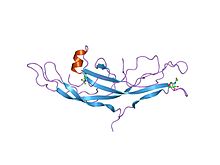- Cystine knot
-
Cystine-knot domain 
Structure of human chorionic gonadotropin.[1] Identifiers Symbol Cys_knot Pfam PF00007 Pfam clan CL0079 InterPro IPR006208 SCOP 1hcn Available protein structures: Pfam structures PDB RCSB PDB; PDBe PDBsum structure summary A cystine knot is a protein structural motif where two disulfide bridges (cystines - formed from pairs of cysteine molecules) are formed. The sections of polypeptide that occur between them then form a loop through which a third disulfide bond passes, forming a rotaxane substructure. It occurs in many proteins across many species and provides considerable structural stability.[2]
This motif was first observed in the structure of Nerve Growth Factor, solved by X-ray crystallography and published in 1991 by Tom Blundell in Nature.[3]
References
- ^ Wu H, Lustbader JW, Liu Y, Canfield RE, Hendrickson WA (June 1994). "Structure of human chorionic gonadotropin at 2.6 A resolution from MAD analysis of the selenomethionyl protein". Structure 2 (6): 545–58. PMID 7922031.
- ^ http://www.cyclotide.com/knots.html
- ^ PDB 1bet; McDonald NQ, Lapatto R, Murray-Rust J, Gunning J, Wlodawer A, Blundell TL (December 1991). "New protein fold revealed by a 2.3-A resolution crystal structure of nerve growth factor". Nature 354 (6352): 411–4. doi:10.1038/354411a0. PMID 1956407.
Categories:- Protein structure
- Biochemistry stubs
Wikimedia Foundation. 2010.
